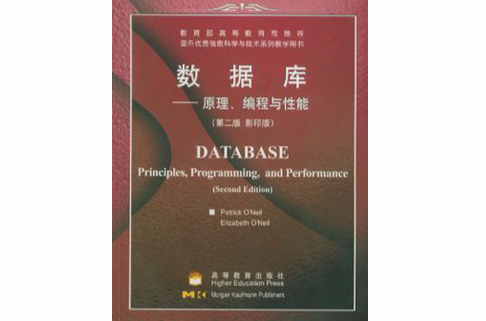《資料庫:原理編程與性能》是2001年高等教育出版社出版的圖書,作者是奧尼爾。
基本介紹
- 書名:資料庫:原理編程與性能
- 作者:奧尼爾
- 原版名稱:Database
- ISBN:9787040100402
- 頁數:870
- 定價:49.50
- 出版社:高等教育出版社
- 出版時間:2001年5月1日
- 裝幀:平裝
- 開本:16開
- 版 次:第2版
作者簡介,內容簡介,目錄,
作者簡介
Parick O'Neil is a professor of computer science at the Uniersity of Massachusetts at Boston. He is responsible for a number of important results in transactonal performance and disk access algorithms,and he holds patents for his work in these and other database areas.
Elizabeth O'Neil is a professor of computer science at the University of Massachusetts at Boston.She serves as a comsult-ant to Sybase IQin Concor, Massachusetts,and has worked with a number of other corporations,includin Microsoft adn Bolt,Beranek,and Newman.
內容簡介
《資料庫:原理編程與性能(影印版)(第2版)》自1994年初版以來,已成為學習、設計及使用關係資料庫人員的一本經典教材。它從理論和實踐兩方面對資料庫設計和編程均做了嚴謹的表述。其內容包括關係理論、資料庫設計、資料庫編程及運行-轉儲結果。每一部分均從基本原理出發,再用實際系統中的實例來說明。
本次修訂版反映了6年來資料庫領域總體的進步和發展動態,書中重點講述了對象關係模型;介紹了一些系統(如Oracle、DB2和Informix等)中通用的新概念;對隔離技術作了更新介紹;對運行結果的表述更現代。相對於初始標準來說,SQL資料庫語言有了非常重要的變化,所以對對象關係給予特別講述。《資料庫:原理編程與性能(影印版)(第2版)》還介紹了SQL-99設計方法及與之相關的原理方法及主要產品。《資料庫:原理編程與性能(影印版)(第2版)》的作者是在資料庫界工作30多年的資深專家,富於教學和實踐經驗。《資料庫:原理編程與性能(影印版)(第2版)》力圖在資料庫領域各不相同的思想和趨勢中找到一個統一的觀點提供給讀者。
《資料庫:原理編程與性能(影印版)(第2版)》對於初接觸資料庫系統的讀者不啻為一本極好的教材;對於那些對資料庫領域的發展還未給予足夠關注的人是一本易於接受的參考書;同時也是設計人員和編程人員及時更新知識的有用的參考書。
內容: 1. 簡介 2. 關係模型 3. 基本SQL查詢語言 4. 對象關係SQL 5. 資料庫編程訪問 6. 資料庫設計 7. 完整性、視圖、安全性和目錄 8. 索引 9. 查詢處理 10. 事務更新 11. 並行與分散式資料庫 附錄A 介紹性指南 附錄B 編程細節 附錄C SQL語句語言 附錄 D 設定查詢計數。
目錄
Foreword
Preface
Chapter 1 Introduction
1.1 Fundamental Database Concepts
History of Database Systems
The Relational and Object-Relational Models
The Database Systems Covered
A Relational Database Example
An Object-Relational Database Example
1.2 Database Users
1.3 Overview of Relational and Object-Relational DBMS
Chapter 2: The Relational Model
Chapter 3: Basic SQL Query Language
Chapter 4: The Object-Relational Model
Chapter 5: Programs to Access a Database
Chapter 6: Database Design
Chapter 7: Integrity, Views, Security, and Catalogs
Chapter 8: Indexing
Chapter 9: Query Processing
Chapter 10: Update Transactions
Chapter 11: Parallel and Distributed Databases
1.4 Putting It All Together
Chapter 2 The Relational Model
2.1 The CAP Database
2.2 Naming the Parts of a Database
Domains and Datatypes
Tables and Relations
2.3 Relational Rules
2.4 Keys, Superkeys, and Null Values
Null Values
2.5 Relational algebra
Fundamental Operations of Relational Algebra
2.6 Set-Theoretic Operations
The Union, Intersection, and Difference Operations
Assignment and Alias
The Product Operation
2.7 Native Relational Operations
The Projection Operation
The Selection Operation
Precedence of Relational Operations
The Join Operation
The Division Operation
2.8 The Interdependence of Operations
2.9 Illustrative Examples
2.10 Other Relational Operations
Outer Join
Theta Join
Chapter 3 Basic SQL Query Language
3.1 Introduction
SQL Capabilities
SQL History-Standards and Dialects
3.2 Setting Up the Database
Standard Typographical Conventions
A Practical Exercise
3.3 Simple Select Statements
3.4 Subqueries
The IN Predicate
The Quantified Comparison Predicate
The EXISTS Predicate
A Weakness of SQL: Too Many Equivalent Forms
3.5 UNION Operators and FOR ALL Conditions
The UNION Operator
Division: SQL "FOR ALL..." Conditions
3.6 Some Advanced SQL Syntax
The INTERSECT and EXCEPT Operators in Advanced SQL
Join Forms in Advanced SQL
OUTER JOIN
Join Forms Implemented in Database Systems
3.7 Set Functions in SQL Handling Null Values
3.8 Groups of Rows in SQL
3.9 A Complete Description of SQL Select
Identifiers
Expressions, Predicates, and the search_condition
Scalar Subqueries as Expressions:Advanced SQL
Basic SQL versus Advanced SQL: Summary
A Discussion of the Predicates
3.10 Insert, Update, and Delete Statements
The Insert Statement
The Update Statement
The Delete Statement
3.11 The Power of the Select Statement
The Non-Procedural Select Statement
Turing Power
Limited Power of the Basic SQL Select Statement
Chapter 4 Object-Relational SQL
4.1 Introduction
ORSQL Capabilities
Form of Presentation for This Chapter
Object-Relational History
4.2 Objects and Tables
4.2.1 Object Types in ORACLE
Definition of the REF Object Reference
4.2.2 INFORMIX Row Types for Objects
Absence of Refs in INFORMIX
Type Inheritance in INFORMIX
4.2.3 Objects and Tables: Summary
Object Orientation
4.3 Collection Types
4.3.1 Collection Types in ORACLE
Table Types and Nested Tables
Two Techniques for Retrieving from a Table of Tables
Unnesting via Table Products
Nested Cursors
Array Types for VARRAYs
SQL Syntax for Collections in ORACLE
Inserts and Updates in ORACLE
4.3.2 Collection Types in INFORMIX
Sets in INFORMIX
Lists in INFORMIX
SQL Syntax for Collections in INFORMIX
inserts and Updates in INFORMIX
4.3.3 Collection Types:Summary
4.4 Procedural SQL, User-Defined Functions (UDFs), and Methods
4.4.1 ORACLE PL/SQL Procedures, UDFs, and Methods
PL/SQL: ORACLE's Procedural SQL Language
Using PL/LQL to Implement Methods in ORACLE
Update Methods
4.4.2 INFORMIX User-Defined Functions
SPL:INFORMIX's Procedural SQL Language
Using SPL to Implement UDFs in INFORMIX
Update Functions
4.4.3 User-Defined Functions:Summary
4.5 External Functions and Packaged User-Defined Types(UDTs)
Binary Data and BLOBs
External Functions
Encapsulation
Distinct Types
BLOB Objects
Packaged UDTs and Other Encapsulated UDTs
Summary
Chapter 5 Programs to Access a Database
5.1 Introduction to Access a Database
A Simple Program Using Embedded SQL
Selecting Multiple Rows with a Cursor
5.2 Condition Handling
Whenever Statement:Scope and Flow of Control
Explicit Error Checking
Handling Error:Getting Error Messages from the Database
Indicator Variables
5.3 Some Common Embedded SQL Statements
The Select Statement
The Declare Vursor Statement
Chapter 6 Database Design
Chapter 7 Integrity, Views, Security, and Catalogs
Chapter 8 Indexing
Chapter 9 Query Processing
Chapter 10 Update Transactions
Chapter 11 Parallel and Distributed Databases
Appendix A Introductory Tutorial
Appendix B Programming Details
Appendix C SQL Statement Syntax
Appendix D Set Query Counts
Solutions to Selected Exercises
Index

